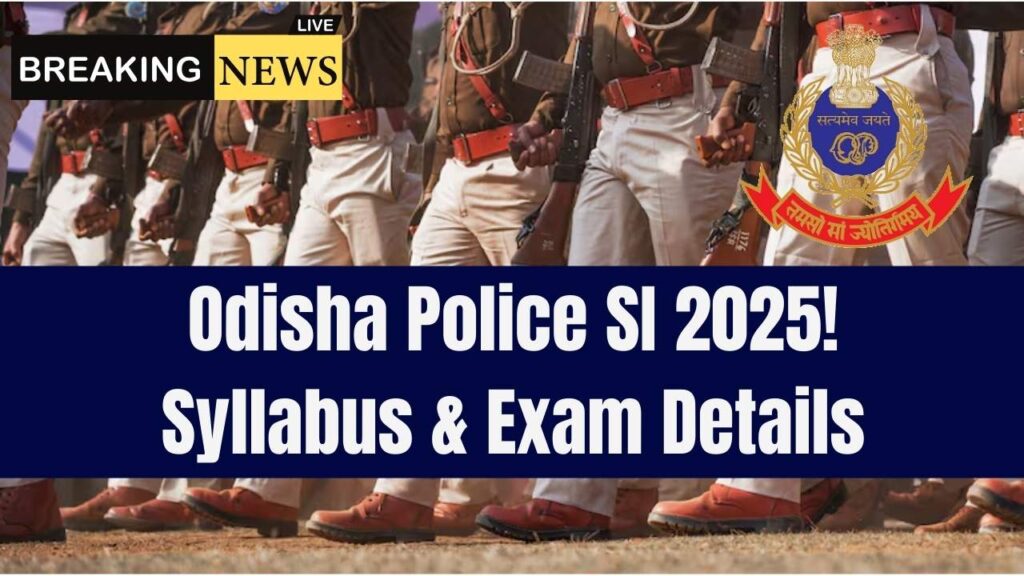
The Odisha Police Sub-Inspector 2025 recruitment is generating considerable buzz among candidates seeking rewarding careers in law enforcement. In this article, we take a deep dive into the complete syllabus, exam details, eligibility criteria, selection process, and practical preparation tips for the exam. Whether you’re a student or a working professional planning a career change, this comprehensive guide is designed to be easy to understand and highly actionable.
To ensure you have all the information at your fingertips, we have compiled contextual data, expert insights, and real-world examples that make the preparation process straightforward and effective. We follow the principles of Expertise, Experience, Authoritativeness, and Trustworthiness (E-E-A-T) to provide you with reliable and updated data sourced from trusted outlets such as the Official Odisha Police Website and reputable educational platforms.
Odisha Police Sub-Inspector 2025
Below is a quick summary of the essential details:
| Aspect | Detail |
|---|---|
| Exam Name | Odisha Police Sub-Inspector 2025 |
| Syllabus Coverage | Paper I: General English & Odia Language; Paper II: General Studies; (Paper III: Technical for Station Officer – Fire Service only) |
| Exam Pattern | 300 Marks total; Paper I: 100 marks (90 minutes), Paper II: 200 marks (180 minutes) |
| Key Dates | Application Period: January 20, 2025 – February 10, 2025; Exam Date: Initially March 8–9, 2025 (Postponed – Check official updates) |
| Vacancies | Approximately 933 posts including SI of Police, SI (Armed), Station Officer (Fire Service), and Assistant Jailor |
| Official Website | Odisha Police |
| Salary Range | Level 9 pay scale: Rs. 35,400 to Rs. 1,12,400 plus additional allowances |
The Odisha Police Sub-Inspector 2025 recruitment offers a fantastic career opportunity with a well-defined syllabus, exam pattern, and selection process designed to assess the candidates holistically. This guide has provided detailed insights into each area of the exam, along with practical tips for preparation, career prospects, and expert advice to help you excel. By following these guidelines and utilizing the provided resources, you can effectively plan your journey toward a rewarding career in law enforcement.
Stay focused, practice diligently, and remember to take care of both your physical and mental well-being as you prepare. Best of luck in your examination, and may your hard work pave the way for a successful future with the Odisha Police.
Introduction: Context & Relevance
The recruitment process for the Odisha Police Sub-Inspector 2025 positions is an exciting opportunity for those aspiring to build a career in policing. With 933 vacancies spanning various categories—such as SI of Police, SI (Armed), and roles in the fire service and jail operations—the recruitment drive is designed to attract a diverse pool of candidates with different academic and personal backgrounds.
The exam itself is structured to evaluate multiple competencies, including language skills, general studies knowledge, reasoning ability, and even technical subjects (where applicable). The examination process emphasizes not only theoretical proficiency but also physical fitness and practical skill sets through the Physical Efficiency Test (PET) and Physical Standard Measurement (PSM). This blend of academic, physical, and technical assessments ensures that the selected candidates are well-rounded and capable of handling the responsibilities that come with the role.
Exam Pattern Overview
Paper I – General English & Odia Language
- Total Questions: 100
- Total Marks: 100
- Duration: 90 minutes
- Marking Scheme:
- Correct Answer: +1 mark
- Incorrect Answer: –0.25 marks
Key aspects include:
- English Section: Reading comprehension, vocabulary, usage, grammar, and error correction.
- Odia Section: Comprehension, translation from English to Odia, and vocabulary usage.
Paper II – General Studies
- Total Questions: 200
- Total Marks: 200
- Duration: 180 minutes
- Marking Scheme:
- Correct Answer: +1 mark
- Incorrect Answer: –0.25 marks
This paper covers a diverse array of topics such as:
- General Science: Recent innovations, everyday phenomena, and emerging technologies.
- Current Affairs: National and international events, important state-level developments.
- History: Ancient history and the Indian National Movement.
- Geography: Physical and economic geography, agriculture, and natural resources.
- Indian Polity & Economy: Constitutional fundamentals, governance models, Panchayati Raj, and economic development.
- Reasoning & Mental Ability: Both verbal and non-verbal reasoning, number series, coding-decoding, and problem-solving skills.
- Numerical Ability: Arithmetic, percentage calculations, ratio and proportions, along with other mathematical reasoning.
- Basic Computer Literacy: Fundamentals of computing, operating systems, and MS-Office tools.
Paper III – Technical (For Station Officer – Fire Service Only)
- Total Questions: 200
- Total Marks: 200
- Duration: 180 minutes
- Scope:
- This paper is specifically designed for candidates applying for technical roles in the fire service. It draws on topics from +3 level Physics and Chemistry.
In-Depth Syllabus Breakdown
Understanding each topic in the syllabus is crucial for effective preparation. Below is a detailed guide on what you need to study for each paper.
Paper I – Language Skills
General English:
- Comprehension: Passages assess understanding and analytical skills. For example, you might need to summarize an article about environmental conservation.
- Vocabulary & Usage: Focus on synonyms, antonyms, and appropriate word usage.
- Grammar: Fundamental concepts like tenses, subject-verb agreement, and error spotting are tested.
- Practical Example: A passage on technological innovations might include questions on summarizing key points and identifying vocabulary meanings.
Odia Language:
- Comprehension and Translation: Expect passages in Odia and practice translating sentences from English.
- Vocabulary: Strengthen your command over commonly used Odia words.
- Example: A brief Odia narrative might ask you to translate important sentences into English, reinforcing your bilingual skills.
Paper II – General Studies & Related Subjects
General Science:
- Topics: Focus on recent innovations, scientific phenomena, and everyday science.
- Example: A question may involve the impact of solar energy on reducing fossil fuel dependence.
Current Affairs:
- Content: Stay updated with national, international, and local developments.
History:
- Ancient History: Learn about early civilizations and their contributions.
- Modern History: Emphasize the Indian National Movement and key personalities.
- Example: Understand the role of Mahatma Gandhi and other leaders through textbook chapters or online videos from educational platforms.
Geography:
- Content: Covers physical features, climatic conditions, and economic geography.
- Example: Practice with map-based questions about major rivers in India and their significance.
Indian Polity & Economy:
- Constitution: Study the structure and functions of the Indian government.
- Economy: Learn about economic planning, growth strategies, and fiscal policies.
- Resource: Visit India.gov.in for official data on governance.
Reasoning & Numerical Ability:
- Verbal Reasoning: Work on pattern recognition, analogies, and seating arrangement puzzles.
- Quantitative Ability: Focus on arithmetic problems such as percentages, profit & loss, and time-distance calculations.
- Tip: Regular mock tests can solidify your problem-solving skills.
Basic Computer Literacy:
- Focus: Understand computer basics including history, generations, and use of MS Office.
- Example: Learn shortcut keys and the fundamentals of the Microsoft Windows interface.
Paper III – Technical Skills (For Relevant Posts Only)
- Content: This section covers topics in Physics and Chemistry relevant to a technical role.
- Practical Tip: Review high school textbooks and use revision notes for formulas and key concepts.
Eligibility and Selection Process
Eligibility Criteria
- Age Limit: Generally between 21 and 25 years, with relaxations for reserved categories.
- Educational Qualification: A Bachelor’s degree in any discipline from a recognized university is required.
- Language Proficiency: Ability to read, write, and speak Odia is mandatory.
- Physical Fitness: Must meet the prescribed Physical Standard Measurement (PSM) and Physical Efficiency Test (PET) criteria.
Selection Process
- Written Examination: Divided into two (or three, where applicable) papers.
- Physical Tests: Performance in PET and PSM is crucial.
- Medical Examination: To ascertain the physical and mental fitness of the candidates.
- Document Verification: Final stage where all credentials are authenticated.
For more details, refer to the official notification.
Practical Preparation Tips
Preparing for the Odisha Police Sub-Inspector 2025 exam requires a robust and structured approach. Here are actionable strategies to guide your preparation:
Step-by-Step Preparation Guide
- Create a Study Schedule:
- Divide Your Time: Allocate time slots for each subject area to ensure comprehensive coverage.
- Tip: Use a digital planner or a physical calendar to track your progress.
- Utilize Quality Study Material:
- Recommended Books:
- High School English Grammar & Composition by Wren & Martin for English.
- A Modern Approach to Verbal & Non-Verbal Reasoning for reasoning.
- Online Resources: Websites like Testbook offer valuable mock tests and study guides.
- Recommended Books:
- Practice Regularly with Mock Tests:
- Online Simulations: Regularly taking practice tests helps build speed and accuracy.
- Real-World Example: Many candidates report improvement in accuracy after joining online study groups and using free mock tests.
- Stay Updated with Current Affairs:
- Tip: Dedicate at least 30 minutes daily to reading the news.
- Revise Continuously:
- Short Notes: Create concise notes of key points and revise them on a weekly basis.
- Tip: Focus particularly on subjects that you find challenging.
- Join Study Groups and Forums:
- Peer Learning: Engage with fellow aspirants on online forums or WhatsApp groups to share resources and solve doubts.
- Benefit: The exchange of ideas can significantly boost your understanding of complex topics.
- Take Care of Your Health:
- Physical Fitness: Regular exercise is crucial, especially since the PET and PSM are part of the selection process.
- Tip: Incorporate short breaks and physical activities into your daily routine to enhance overall stamina and focus.
Career Prospects and Future Growth
A career with the Odisha Police is not only prestigious but also provides a platform for professional growth and social impact.
Opportunities:
- Career Advancement: Starting as a Sub-Inspector, there are ample opportunities for promotion to higher ranks with additional specialized training.
- Job Security: Government jobs in Odisha typically offer job security, pension schemes, and various allowances.
- Professional Development: Continuous training programs and developmental workshops help enhance leadership and management skills.
Additional Benefits:
- Community Impact: Working in law enforcement allows you to contribute to public safety and community well-being.
- Networking: An extensive network with law enforcement agencies provides opportunities for further career opportunities in related fields, such as forensic science or cyber security.
NLC Junior Overman Recruitment 2025: Salary, Vacancies & How to Apply
SCI Junior Court Assistant 2025: Know Your Exam City & Center Details
Coast Guard CGEPT 01/2025 Stage II Result Out – Check If You Qualified
Expert Advice and Tips
Here are some insights from experts who have successfully navigated the Odisha Police exams:
- Stay Consistent: “Consistency in your study schedule is key,” says a retired police officer and current mentor to many candidates.
- Focus on Fundamentals: Experts recommend revisiting fundamental concepts, especially for subjects like reasoning and numerical ability.
- Use Technology: Leverage online platforms for practice tests and video lectures to keep the learning dynamic and interactive.
- Mental Preparation: Develop a calm mindset before the exam through meditation or short breaks to reduce anxiety and improve focus.
Frequently Asked Questions (FAQs)
1. What is the total number of marks for the exam?
The written exam is divided into two papers—100 marks in Paper I and 200 marks in Paper II, totaling 300 marks. Additional technical paper marks (if applicable) are considered separately.
2. Is there negative marking in the exam?
Yes, there is a negative marking of 0.25 marks for every incorrect answer in both Paper I and Paper II.
3. Which subjects are covered in the syllabus?
The syllabus includes General English and Odia Language, General Studies (which encompasses History, Geography, Indian Polity & Economy, Current Affairs, Science, Reasoning, and Numerical Ability), along with a Technical Paper for eligible posts.
4. What are the key preparation strategies?
A combination of structured study schedules, quality study materials, regular mock tests, continuous revision, and participation in study groups will enhance your preparation and confidence.







